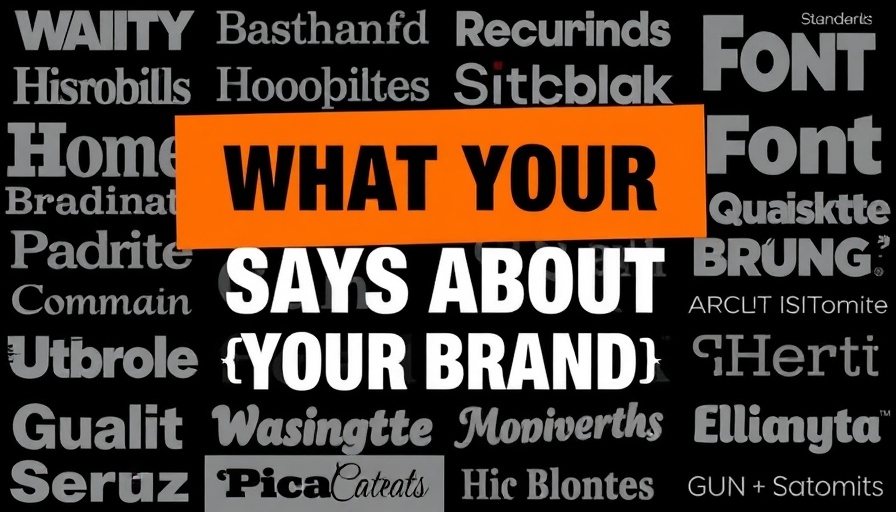
Understanding Brand Identity Through Font Choices
When it comes to branding, typography plays a pivotal role that is often underestimated. Your choice of font does more than just convey text; it communicates the essence of your brand’s identity and influences consumer perception. In a world where first impressions matter, selecting the right font can help convey your brand’s values, tone, and personality, ultimately impacting your digital marketing strategies.
The Power of Typography in Branding
Fonts are much more than decorative elements on a webpage. According to a study by University of Alberta, the impact of typography goes beyond mere aesthetics; it directly influences how consumers perceive the credibility and reliability of a brand. For example, sans-serif fonts, which are clean and modern, might suggest innovation and forward-thinking, while serif fonts often convey tradition and reliability. Understanding these nuances can empower business owners and digital marketers alike to make informed decisions that resonate with their target audience.
Visual Identity and Brand Recognition
One major component of effective digital marketing is brand recognition, and typography plays a significant role in cementing your visual identity. Brands like Coca-Cola and Nike have established iconic typographical elements that consumers instantly recognize. Engaging in content marketing strategies that reflect your unique typography can foster a stronger emotional connection with your audience.
In today’s fast-paced digital landscape, users are bombarded with content. Utilizing well-chosen fonts can differentiate your brand and capture attention in social media feeds and online ads. As you consider your design, integrating SEO updates with an eye-catching font could improve click-through rates and user engagement.
Emotional Triggers and Consumer Behavior
Your font choice can evoke specific emotions in consumers, influencing their behavior and decision-making processes. Research indicates that typefaces can affect how consumers feel about a brand, and thus their likelihood to convert. For example, rounded fonts can seem more casual and friendly, appealing to a laid-back demographic, whereas sharp-edged fonts can be interpreted as more professional and authoritative.
With the rise of digital marketing, conversion rate optimization efforts can be enhanced by experimenting with different font types. A/B testing different fonts can lead to insights into user preferences and behaviors. Therefore, marketers should not only focus on the visual aspects of their content but also how those choices affect emotional responses.
Future Predictions: Typography Trends in Digital Marketing
As we move towards 2025 and beyond, fonts are becoming more than just static components of design. With evolving technologies like augmented reality (AR) and voice commerce strategies, typography will need to adapt. Businesses will have to consider how their fonts appear across various platforms, whether it’s a smartphone screen or a virtual reality setting. Being updated on digital marketing trends is vital for staying ahead.
For example, interactive fonts that change shape or color in response to user interaction may become more prevalent, encouraging further engagement and enhancing the user experience.
Incorporating Fonts into Your Marketing Tools
In a world dominated by social media marketing trends, ensuring that your typography stands out is key. Tools like Adobe Fonts and Google Fonts offer vast libraries for brands to explore and integrate typographical elements into their design. Marketers should take advantage of these resources to align their typography with overall branding.
Furthermore, using responsive and adaptive typography can improve mobile user experiences, conforming to screen sizes while retaining legibility and appeal. Implementing website optimization tips in line with typography choices could enhance user satisfaction and retention.
Actionable Insights: Choosing the Right Font
When selecting a font for your brand, consider these points:
- Understand Your Audience: Different demographics respond to different typographic styles.
- Consistency is Key: Use a consistent typeface across all marketing platforms to strengthen brand recognition.
- Test and Optimize: Regularly A/B test different fonts to see which ones your audience responds to more favorably.
Conclusion
In the competitive landscape of digital marketing, every aspect of branding counts, from the colors you choose to the fonts you use. As fonts become increasingly integrated into various mediums, understanding their impact can significantly influence marketing success. Business owners and digital marketers should stay informed about digital marketing news and continuously explore how typography can enhance their branding efforts. Remember, your font is more than just words on a page; it’s a vital part of your communication strategy.
 Add Row
Add Row  Add
Add 




Write A Comment